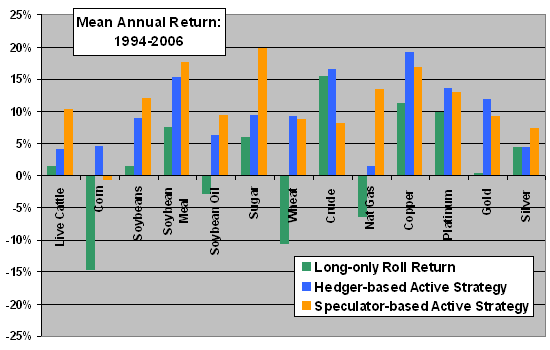Do commodity hedgers offer a reliable risk premium to speculators via commodity futures? In other words, can commodity futures traders generate dependable returns by trading against the net position of hedgers and with the net position of speculators as summarized in the weekly Commodity Futures Trading Commission’s Commitments of Traders (COT) reports? In the February 2009 version of their paper entitled “The Performance of Simple Dynamic Commodity Strategies”, Devraj Basu and Joelle Miffre construct real-time trading strategies based on the aggregate positions of hedgers and speculators for liquid commodity futures. They test the relative informativeness of hedgers and speculators and the effectiveness of applying active strategies to commodities that are backwardated (positive roll return) and contangoed (negative roll return). Using Wednesday closing prices on near-maturity contracts for 13 commodities (identified on the chart below) and weekly COT hedgers/speculators position data over the period 1994-2006 (1999-2006 for corn), they find that:
- On an equal-weighted basis across all 13 commodities, the overall mean annual return over the entire sample period is:
- 1.7% for a simple long-only roll return.
- 8.4% for a simple long-only roll return applied only to backwardated commodity futures. (Simple long-only roll return relates positively and strongly to the level of backwardation.)
- 9.6% for an active strategy that buys those commodity futures for which hedgers are net short the prior week (in backwardated markets) and sells those commodity futures for which hedgers are net short the prior week (in contangoed markets).
- 11.1% for an active strategy that buys those commodity futures for which speculators are net long the prior week (in backwardated markets) and sells those commodity futures for which speculators are net short the prior week (in contangoed markets).
- A one-week lag between COT position data and buy-sell action is optimal for active timing of 11 of the 13 commodities. A two-week lag is optimal for corn, and a four-week lag is optimal for sugar.
- Both the backwardated and contangoed positions contribute substantially to the active strategy returns.
- The net positions of speculators better explain the variability of commodity futures prices than do the net positions of hedgers.
The following chart, constructed from data in the paper, compares mean annual returns for 13 commodity futures over the period 1994-2006 (1999-2006 for corn) based on the following three strategies:
- A Long-only Roll Return strategy consisting of long positions in all 13 commodities, holding the contracts nearest to maturity until one month to maturity and then rolling to the next contract in sequence.
- A Hedger-based Active Strategy, with the same time to maturity rules, that buys those commodity futures for which hedgers are net short the prior week (in backwardated markets) and sells commodity futures for which hedgers are net short the prior week (in contangoed markets).
- A Speculator-based Active Strategy, with the same time to maturity rules, that buys those commodity futures for which speculators are net long the prior week (in backwardated markets) and sells commodity futures for which speculators are net short the prior week (in contangoed markets).
The chart shows that the active strategies based on information in COT reports generally outperform simple long-only roll-return. The speculator-based strategy outperforms the hedger-based strategy for seven of 13 commodities.

In summary, traders may be able to exploit information on hedger and speculator net positions in the Commitment of Traders report to time positions in associated commodity futures.
The study does not address any trading frictions involved in executing the strategies or potential data snooping bias, and its statistical approach assumes that the distribution of commodity futures returns is normal. Note that mean returns cover a period of perhaps two economic expansions and one contraction.